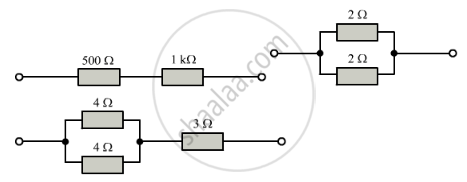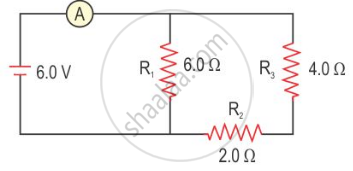Advertisements
Advertisements
Question
Solution
A/c toOhm's law
R = `"V"/"I"`
Here V = 0.1 volt and I = 2 A
R = `0.1/2` = 0.05Ω
APPEARS IN
RELATED QUESTIONS
Calculate the combined resistance in each case:

The diagram below shows part of a circuit:

If this arrangement of three resistors was to be replaced by a single resistor, its resistance should be:
(a) 9 Ω
(b) 4 Ω
(c) 6 Ω
(d) 18 Ω
What potential difference is needed to drive a current o f 1 A through a 5 Ω resistor?
Three resistors of 6.0 Ω, 2.0 Ω and 4.0 Ω are joined to an ammeter A and a cell of emf 6.0 V as shown in the following figure. Calculate :
- the effective resistance of the circuit.
- the reading of ammeter.

How does the resistivity of an alloy such as constantace depends on temperature.
Define the term resistivity and state its S.I. unit. Which will have higher resistivity a conductor or an insulator.
State and explain the laws of resistance.
What should be the length of a nickel wire of area of cross-section 3 mm2 used for making a rheostat of 750 ohm? (ρ of nickle = 0.069 Ohm mm2/m)
Two wires of same material and same lengths have radii in the ratio of 2 : 3, Compare their resistances.
